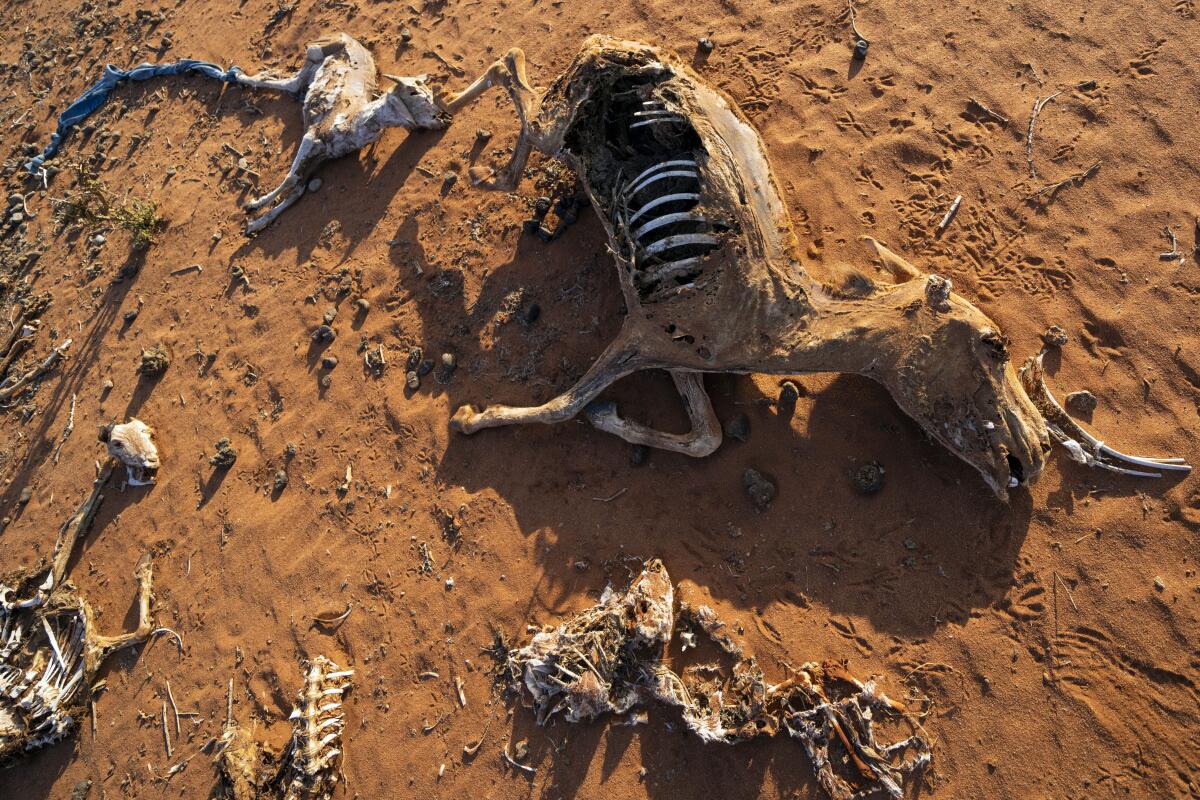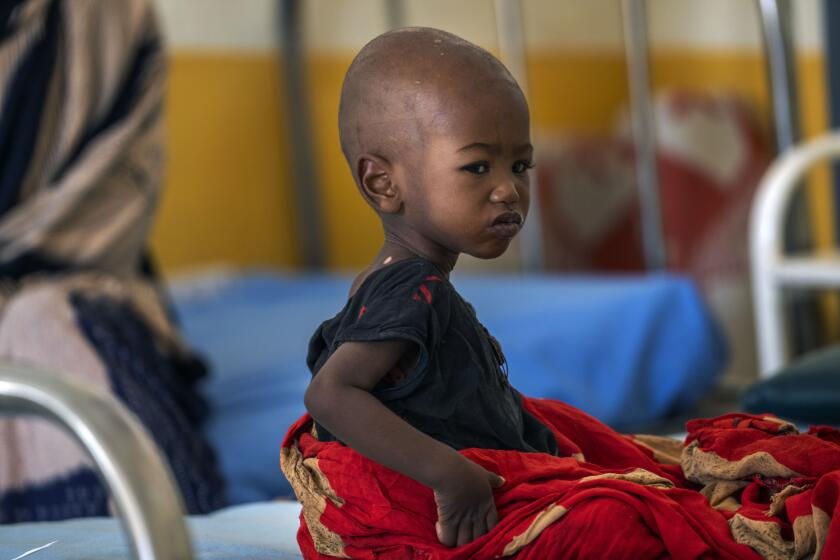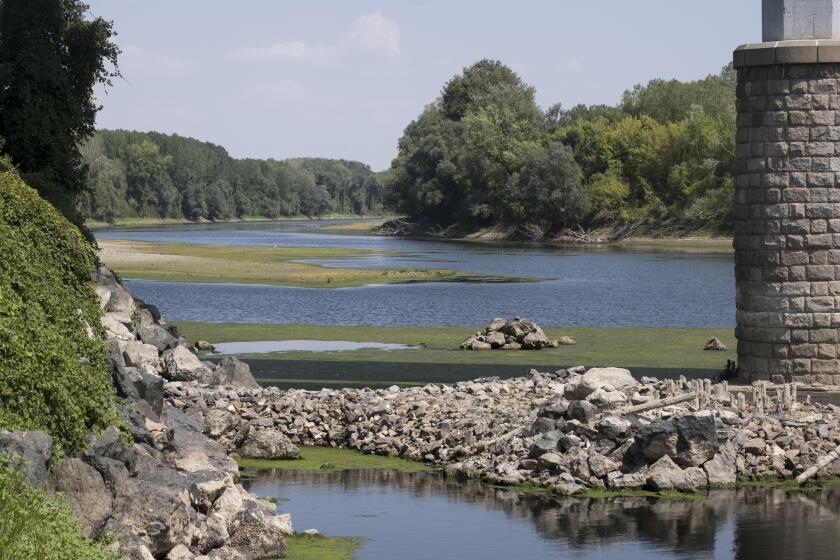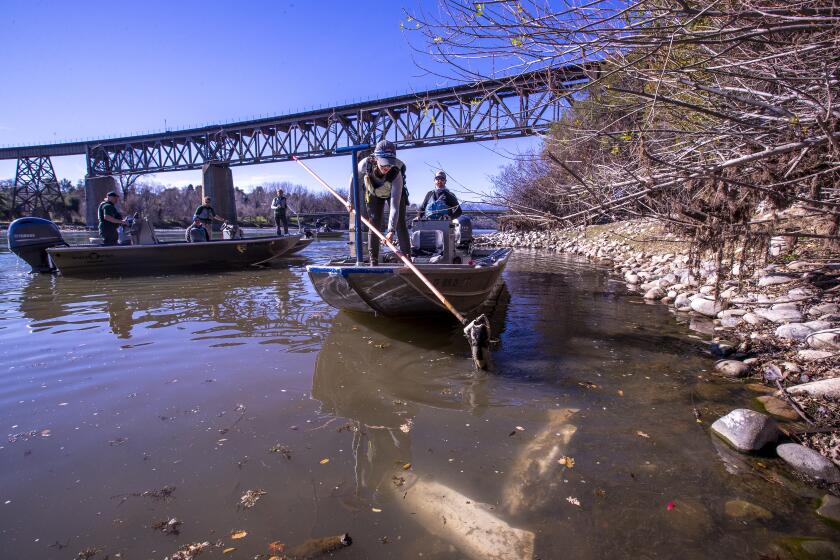‘So many children dying’: Catastrophic drought in Somalia brings threat of famine

- Share via
DOLLOW, Somalia — A man in a donkey cart comes wheeling through the dust, carrying two small, silent boys. The sky is overcast. It could rain. It won’t. It hasn’t for a very long time.
Mohamed Ahmed Diriye is 60 years old, and he’s completing the grimmest journey of his life. He set off from a seaside city on the northern edge of Somalia two weeks ago. People were dying. Livestock was dying. He decided to abandon work as a day laborer and flee to the other end of the country, crossing a landscape of animal carcasses and Islamic-extremist-held territory along the way.
Seven hundred miles later, he is exhausted. The food has run out. He clutches a battered stick in one hand, the nearly empty cart in the other. His boys are just 4 and 5.
They had tried to escape, Diriye says. “But we came across the same drought here.”
More than 1 million Somalis have fled and discovered that too.
Within weeks, the U.N. could declare a famine in Somalia, affecting hundreds of thousands of people.
Somalis say the current drought is worse than any they can remember. It has astonished resilient herders and farmers by lasting four failed rainy seasons, starting two years ago. The fifth season is underway and probably will fail too.
A rare famine declaration could be made as soon as this month, the first significant one anywhere in the world since Somalia’s famine in 2011. Thousands of people have died, including nearly 900 children under age 5 being treated for malnutrition, according to United Nations data. The U.N. says half a million such children are at risk of death.
As the world is gripped by food insecurity, Somalia, a country of 15 million people shaking off its past as a failed state, can be considered the end of the line. It is stumbling amid several global crises descending at once.
They include: Climate change, with some of its harshest effects felt in Africa. Russia’s invasion of Ukraine, which stalled ships carrying enough grain to feed hundreds of millions of people. A drop in humanitarian donations, as the world shifted focus to the war in Ukraine. And one of the world’s deadliest Islamic extremist groups, which limits the delivery of aid.

The Associated Press spoke with a dozen people in rapidly growing displacement camps during a visit to southern Somalia in late September. All say they’ve received little aid, or none. A day’s meal might be plain rice or just black tea. Many camp residents, overwhelmingly women and children, beg from neighbors, or go to sleep hungry.
Mothers walk for days or weeks through bare landscapes in search of help, at times finding that the withered, feverish child strapped to them has died along the way.
“We’d grieve, stop for a while, pray,” Adego Abdinur says. “We’d bury them beside the road.”
Residents are conserving water at a commendable pace, but officials say warmer and drier conditions await.
She holds her naked 1-year-old in front of her new home, a fragile hut of plastic sacks and bare branches. It’s one of hundreds scattered over the dry land.
Abdinur and her six children walked about 185 miles to get here, following rumors of assistance along with thousands of other people.
“We have seen so many children dying because of hunger,” she says.
At the heart of this crisis, in areas where famine probably will be declared, is an Islamic extremist group linked to Al Qaeda. An estimated 740,000 of the drought’s most desperate people live in areas under the Shabab’s control. To survive, they must escape.
Europe is facing one of its worst droughts ever, as rivers dry up, farms go fallow and vineyards roast.
The Shabab’s grip on large parts of southern and central Somalia was a major contributor to deaths in the 2011 famine.
Last month, the Shabab called the drought a test from God, “a result of our sins.” The group claimed it had offered food, water and free medical treatment to more than 47,000 people since last year.
But in rare accounts of life inside Shabab-held areas, several people told the AP that they had seen no such aid. Instead, they said, the extremists continue their harsh taxation of families’ crops and livestock even as they withered and died. They spoke on condition of anonymity for fear of retaliation.
Some flee at night to escape the fighters’ attention, with men and even young boys often being forbidden to leave. One woman says people who received assistance from the outside would be attacked. Weeks ago, she says, the Shabab killed a relative who had managed to take a sick parent to a government-held city and then returned.
News Alerts
Get breaking news, investigations, analysis and more signature journalism from the Los Angeles Times in your inbox.
You may occasionally receive promotional content from the Los Angeles Times.
Those who fled the Shabab now cling to a bare existence. In the only treatment center for the most severely malnourished in the immediate region, Hamdi Yusuf, 1, is a sign of hope.
She was little more than bones and skin when her mother found her unconscious, two months after arriving in the camps. “The child was not even alive,” recalls Abdikadir Ali Abdi, acting nutrition officer with the aid group Trocaire.
Now the girl is revived. But the ready-to-use therapeutic food so crucial to the recovery of children like her could run out in the coming weeks, Abdi says.
The girl’s mother, 18-year-old Muslima Ibrahim, anxiously rubs her daughter’s tiny fingers. Survival will require the kind of support she still hasn’t seen.
As drought worsens, farmers and city dwellers are cutting their water use to historic lows, but it’s California’s environment that suffers the most.
“We received a food distribution yesterday,” Ibrahim says. “It was the first since we arrived.”
Hundreds of families continue to emerge from the empty horizon across Somalia, bringing little but grief.
One day in September, 29-year-old Fartum Issack and her husband carried a small body along a dusty track to a graveyard. Their daughter, 1, had arrived at camp sick and hungry. She was rushed for treatment, but it was too late.
The graveyard opened in April and already had 13 graves. There’s easily room for hundreds more.
Issack and her husband buried their daughter in the middle of the empty ground.
“We wanted to easily recognize her,” Issack says.
At the camp, eight other hungry daughters are waiting.
More to Read
Sign up for Essential California
The most important California stories and recommendations in your inbox every morning.
You may occasionally receive promotional content from the Los Angeles Times.

















